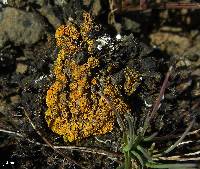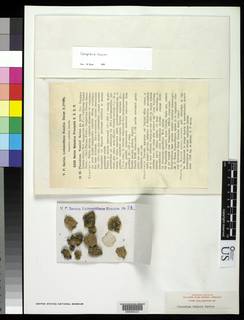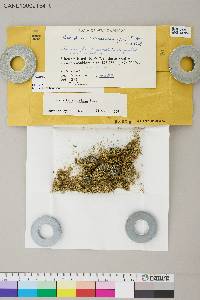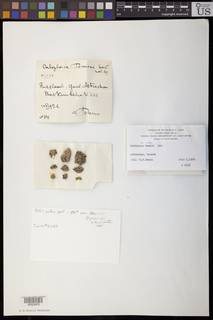
Consortium of Lichen Herbaria
- building a Global Consortium of Bryophytes and Lichens as keystones of cryptobiotic communities -
- Home
- Search
- Images
- Species Checklists
- US States: O-Z >
- US National Parks
- Central America
- South America
- US National Parks
- Southern Subpolar Region
|
|
|
|
Family: Teloschistaceae
[Callopisma tominii Savicz, moreCaloplaca tominii Savicz, Gasparrinia tominii Savicz, Placodium tominii Savicz] |
Nash, T.H., Ryan, B.D., Gries, C., Bungartz, F., (eds.) 2007. Lichen Flora of the Greater Sonoran Desert Region. Vol 3. Life habit: lichenized Thallus: crustose, areolate, margin slightly lobed or notched, without elongated lobes; prothallus: absent surface: orange, smooth, sorediate soredia: fine, in irregular, laminal or marginal soralia cortex: cellular, 15-35 µm thick, granules absent; medulla paraplectenchymatous, without granules Apothecia: rare, adnate, 0.3-0.5 mm in diam., lecanorine disc: orange, flat margin: persistent, raised; thalline margin present, concolorous with thallus; proper margin visible, concolorous with disc parathecium: consisting of radiating hyphae; exciple below hypothecium prosoplectenchymatous epihymenium: golden, K+ red, H-, 10%N-, cN-, C- hymenium: hyaline, 60-70 µm tall paraphyses: 2-3 tip cells swollen, frequently branched; subhymenium: hyaline asci: cylindrical, 8--spored ascospores: hyaline, 2 locules, ellipsoid, 15.5-18 x 5.5-10 µm, isthmus 1.5-3 µm, spore end wall thin Pycnidia: not observed Spot tests: apothecial margin K+ red, H-, 10% N-, cN-, C-; thallus K+ red, H-, 10%N-, cN-, C-; medulla IKI- Secondary metabolites: parietin, fallacinal, emodin, and teloschistin. Substrate and ecology: on soil World distribution: Europe and North America Sonoran distribution: Arizona. Notes: Caloplaca tominii can be recognized by its slightly lobed, convex, sorediate areoles usually growing on soil. It is sometimes very difficult to tell from C. citrina. Caloplaca citrina usually grows on rock and is often fertile while C. tominii never grows on rock and is seldom fertile and the areoles are usually convex. If apothecia are present on C. tominii the spore size is reported to be much bigger, but not always. The size of the spores varies with the number of spores per ascus. The tips of the paraphyses are almost never branched in C. citrina but are frequently branched several times in C. tominii. In C. tominii corticate areoles predominate but in C. citrina soredia predominate. The soredia in C. tominii are often greenish yellow but in C. citrina the soredia are usually orange. Starting with Nordin (1972), treatments often list Caloplaca tominii as authored simply by Savicz and cite the same publication as given for the basionym above. But in that original publication Placodium tominii is given in bold, and the apparently unpublished Caloplaca tominii is given as synonym. |
Powered by Symbiota













































































































